Types of stock certificates
The primary difference between stocks and bonds is explained at "Certificates." The basic idea is that stock certificates represent part ownership of companies. With about 28,000 railroad companies identified so far, it is easy to understand how companies created many different methods of dividing their ownership and, consequently, devised numbers of different ways of describing their stock. In fact, over a hundred different names are recorded so far. Be assured that some are obscure and represented by only a few certificates. One would have a very difficult time trying to collect one certificate of every different way of naming stock.
(Since this project is about collectible certificates, I will use the past tense to explain the purpose of the following certificates instead of trying to explain both present and past in contorted language. Even though some certificate types may no longer exist, be assured that similar market forces, and motivations, remain.)
Capital stock
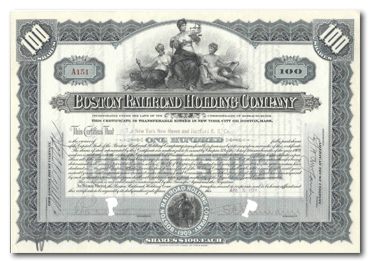
Well over 99% of all recorded railroad stock certificates can be classified as "capital stock." That designation encompasses the total of all shareholder equity in a company. Most collectible stock certificates display the word "capital" in the first few lines of text.
Seven-eights of all rail- and coal-related companies currently catalogued in this project decided "capital stock" was sufficient for their purposes. The remainder felt it necessary to divide capital stock into two or more sub-categories. The two most popular subdivisions were "common stock" and "preferred stock."
Common stock
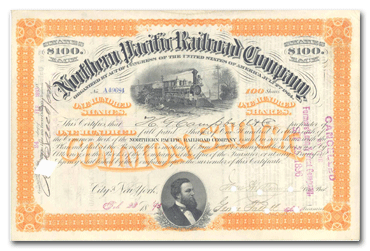
Unless companies also issued preferred stock, there was no substantive difference between common stock and capital stock. They represented the same share of equity and had the same rights. If there was money left after paying all other debts, "dividends" were divided equally on a per-share basis either quarterly, semi-annually or annually. Certificates normally indicated their nature with words like "common stock" or "common capital stock."
Preferred stock
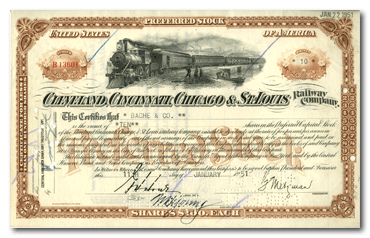
Preferred stock had a degree of preferred status over common stock, generally in the disbursal of dividends. Preferred stockholders were usually guaranteed a dividend at a stated annual percentage of par value. Payments were usually made quarterly. Preferred stockholders were always paid before common stockholders . In many respects, preferred stock occupied a middle ground between stocks and bonds. As holders of equity, preferred stockholders received funds from liquidations of companies before common stockholders, but only after all other debts had been satisfied.
While the term "preferred" means preferred treatment in respect to dividends and funds from liquidation, it did not necessarily mean "better."
Since preferred stockholders received fixed dividends, they did not benefit when profits were elevated. Moreover, because dividends were fixed, their stock prices did not rise and fall to the degree of common stock. If the par value of a preferred stock was $100, and the company was financially stable, its market price tended to fluctuate around $100 in the absence of outside factors. If, on the other hand, inflation trended up, market prices for preferred stock dropped because other higher-yielding investments became more attractive. In periods of low interest, market prices of preferred stocks rose and their shares became attractive investments because their yields might have exceeded other opportunities.
Another issue of difference from common stock was voting rights. In many cases, preferred stockholders did not participate in voting on corporate issues.
Since preferred shares represented a constant and ongoing commitment to pay fixed dividends, only stronger companies issued preferred shares. When they did, those companies usually issued fewer shares of preferred stock than common stock. That reality is represented in the number of collectible certificates recorded in this this project. Preferred certificates are substantially scarcer than common stocks. Although collectors are currently unwilling to pay premiums for preferred certificates, they make up less than 7% as many serial numbers as certificates labeled as common or capital stocks.
The "guaranteed" dividends offered by preferred stocks created a number of "what if" scenarios. For instance, what happened is a company missed dividend payments? What happened if management were unresponsive? What happened if a shareholder wanted to convert from preferred to common shares? What happened if a company wanted to retire preferred shares?
Obviously, every company encountered different types of problems with the many different ways of handling them. Never mind they needed to plan for events that might lie in the future. Collectible certificates currently show over 35 variations of names for "preferred" certificates. While those certificates usually contain some text suggesting their purposes, understanding exact meanings today might require examinations of corporate records.
Falling into a similar category of needing clarification are a few collectible stock certificates labeled as "guaranteed." One would assume the certificates were guaranteeing dividends. Nonetheless, one could question why companies avoided the word "preferred."
Debenture stock
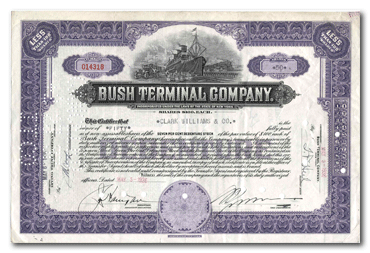
Fewer than 25 varieties (and a small number of actual certificates) have been recorded with titled as "debenture stock." All came from Canadian companies plus one of British origin that funded a Mexican railroad. Debenture stock falls into a middle ground between full-fledged debentures and preferred stock. Debentures were bonds that guaranteed repayment, but were not secured by specific property or equipment. In effect, when investors bought debentures, they were making personal loans to companies based strictly on the good reputations of those companies.
Like debentures, "Debenture stocks" were loans made to companies but were secured by property in a manner similar to ordinary common stock. Like preferred stock, they received regular interest payments but not voting rights. In the case of default, holders of debenture stock were treated like any ordinary stock holder, except that their repayments took precedence over common and preferred shares.
Trust certificates
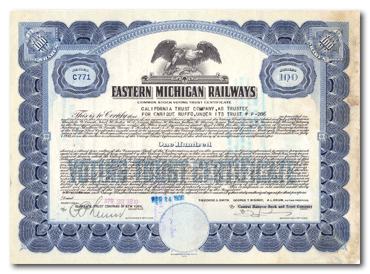
Trust certificates were named, denominated and otherwise identical to regular stock certificates with the term "trust" appended. Stockholders had traded their genuine stock certificates for trust certificates in order for trustees to conduct some kind of business that required votes of shareholders. Generally that purpose was to concentrate voting power in the hands of trustees in order to affect some change in the operations of companies.
A tiny number of collectible "trustees' certificates" are known from 1877, but the first labeled as a "guaranteed trust" certificate appeared in 1882. Trust certificates were highly instrumental in several of the large reorganizations of railroad companies in the 1890s such as the Northern Pacific, Union Pacific, Philadelphia & Reading, Erie, St Louis & San Francisco, and others. No physical trust certificates of those important reorganizations are currently known among collectibles, but most existing stock trust certificates date from that period.
The use of trust certificates separated "legal titles" to stock certificates from "equitable" titles. In other words, the various trusts legally owned stock certificates for the purpose of voting on corporate issued, but passed dividends along to the holders of trust certificates. In general, trustees assumed the tasks of re-shaping failing companies or foreclosing on them, setting up new companies, and then trading full-fledged stock certificates back to original stockholders. Regardless of whether original certificates were capital, common, or preferred, stockholders could buy, sell,, and profit from trust certificates exactly like regular certificates. The only difference was that trustees held voting power.
Because ordinary stockholders received the "benefits" of stock ownership, some certificates were labeled as "beneficiary certificates," "certificates of beneficial interest" or "beneficial shares." Trust certificates from a few companies are known in substantial numbers, but they are scarce when one counted against the many millions issued.
Stock certificates labeled with other names
This project had recorded a little over two dozen additional names for types of stock certificates by early 2021. "Corporate stock" alone accounted for over half of those collectible certificates and that designation probably represented the equivalent of capital stock. All others types of names are scarce, rare, or unique in the database. With the possible exception of a single record of "employee stock" and a lone "promoter's certificate," most probably served purposes like those described above with perhaps only slight adjustments in intent.